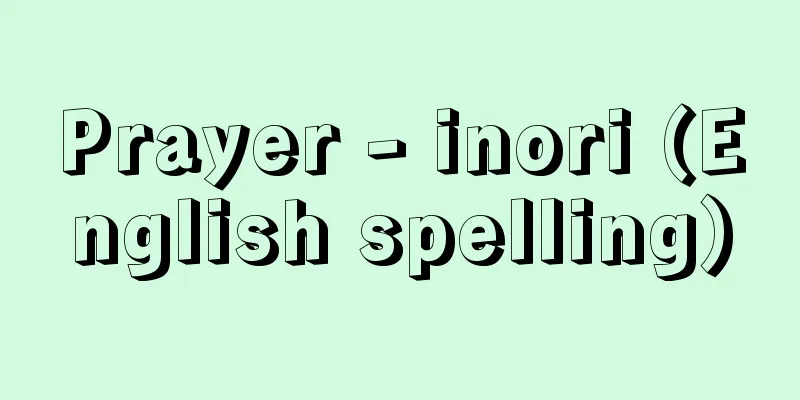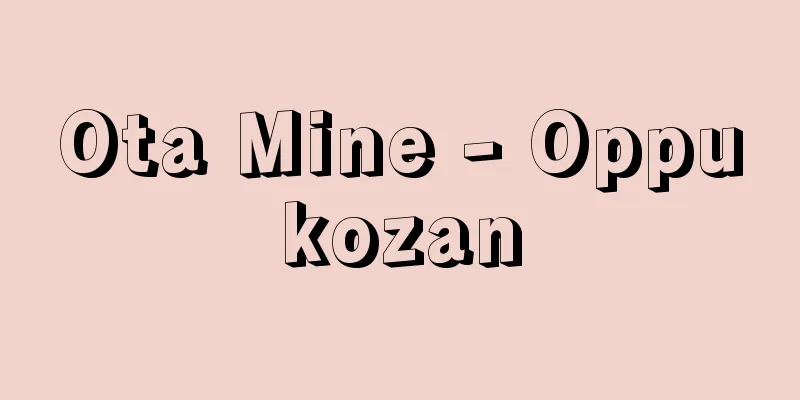Prayer - inori (English spelling)

|
Prayer, as a basic element of religious phenomena, exists in all religions, whether primitive religions, ethnic religions, or world religions. Religious rituals are classified into negative and positive rituals in terms of the relationship between the sacred and the secular. Negative rituals focus on the distinction between the sacred and the secular, such as taboos, while positive rituals aim to unite the sacred and the secular. Prayer is a representative positive ritual. Prayer is "inner communication, contact, and dialogue between humans and those that transcend humans (supernatural powers, ultimate reality, God, Buddha, etc.)" and can be considered religious communication in analogy with social communication between people. [Noriaki Akaike] ContentsPrayers can have a variety of characteristics, ranging from those that expect practical effects to non-utilitarian wishes. They can be supplications, petitions, and supplications for worldly benefits such as protection from disasters and protection from good fortune, or for eternal youth and longevity; repentance, enlightenment, intercession, and gratitude that are connected with the deepening of faith; or adoration, obedience, devotion, and praise that maintain and strengthen a faith system. Prayers have complex and multifaceted content depending on the feelings, attitudes, intentions, and motives of individuals and groups. [Noriaki Akaike] formatJust as language is the basic medium of human relationships, the most common form of prayer expression is "verbal prayer." All religions use forms of verbal expression such as ritual texts, chanting, and hymns. However, there is also "non-verbal vocal prayer" as seen by shamans, and some also use the method of "silent prayer." When words are written down and prayers and scriptures are created, standardized prayer phrases are recited. This is called "written prayer" and is distinguished from "free prayer," in which one expresses one's feelings freely. There is also a distinction between "public prayer," which is prayer performed by clergy and other religious authorities in a set order, and "private prayer," which is personal prayer. Like words, gestures are also important as a means of expressing prayer. Gestures such as bowing the head, joining hands, clapping hands, prostrating, and making the sign of the cross are all expressions of prayer through movement. As the language and actions complement each other and take shape, and traditional sacredness is added, it develops into worship and liturgy. [Noriaki Akaike] TypeHeiler, a German scholar of religion, categorizes forms of prayer into "mystical prayer" and "prayer of prophetic religions." The former regards prayer as a union with divinity, and idealizes a state of transcendence and liberation through identification of the self with ultimate reality. This form is seen in Indian religions, Buddhism, ancient Greek religions, and other religions, and is a type of prayer that seeks to gradually reach the depths of mystical union through means of concentration and meditation. The latter differs from the syncretic character of mysticism in that it is a prayer that exists through a relationship of tension. It is a prayer that presupposes a separation between an absolute God or a transcendent personality and human existence, yet seeks salvation for the soul through a relationship with it. It is a characteristic common to Judaism, Christianity, Islam, and other religions. [Noriaki Akaike] Aspects of PrayerThe prayers of primitive religions were centered on spells and magic, with the intention of humans using prayer to manipulate beings beyond the human to achieve their goals. One theory is that the failure of magical manipulations frustrated the attitude of seeking worldly gain, elevating prayer to worship and devotion. However, even in developed religions, primitive, simple prayers continue to survive, and the prayers of primitive religions are considered the "prototype of prayer." In Japanese Shinto, public prayers are called "matsuri" (festivals). Their primary purpose is to pray for the protection of the gods and appease their anger, but many are associated with agricultural rites. Prayers for the welfare and safety of the community are also frequently held, and the "Oharae no Norito" (Great Purification Prayer), which cleanses the people of their sins and impurities, is a classic example of a written prayer. Private prayers are also popular, and methods such as pilgrimages to shrines and retreats into seclusion are used. In China, Confucianism was responsible for national prayer, while Taoism was responsible for personal prayer. Confucian national rituals were ceremonies based on the idea of heaven and ancestor worship. Prayers to heaven, the source of the universe, were integrated with reverence for a moral order centered on blood ties. The Book of Rites is famous as a prayer textbook. Taoism, while incorporating elements of folk beliefs, formed the idea of immortality and had a widespread influence on people who prayed for worldly bliss, such as immortality. For Indians, the greatest concern in life is liberation from the cycle of reincarnation that binds humans to the past, present and future. The desire for liberation became the Vedas, hymns to the gods. In addition, yoga was used to develop training methods for liberation. As Hinduism developed, the "bhakti (devotion) movement" spread in response to the aspirations of the people, and the hope of liberation through divine grace gave rise to a life of fervent prayer. Buddha taught that anyone can attain nirvana by realizing the law of dependent origination. The Four Noble Truths and the Eightfold Path are the way to discover the truth of selflessness and the practice of achieving the ultimate unity of human existence and the law. "Mystical prayer" has remained an undercurrent in subsequent Buddhism, but it has taken on a variety of forms as it has spread to various places. Esoteric Buddhism considers the sympathy between people and Buddha through "incantation prayer" to be the essence of prayer, while Pure Land Buddhism preaches the idea of a "Saving Buddha" through the Buddha's mercy. Japan's Jodo Shinshu sect bases its faith on the original vow of Amida Buddha and encourages prayer for rebirth in the Pure Land through chanting the Nembutsu. Zen Buddhism is characterized by the concept of "kenshojobutsu" (seeing nature and attaining Buddhahood), and believes that through zazen (zazen) and koan (koan), one can discern the true nature of Buddha and reach the state of enlightenment. Judaism is based on the idea of a "covenant" between the one and only God, Yahweh, and the chosen people, Israel, and the theme of prayer is the intercession of the nation by priests and prophets. The Book of Leviticus in the Old Testament teaches the regulations for worship from the priestly standpoint. In times of national decadence and despair, prophets emerged to emphasize the concept of a "God of righteousness," warn against rebellion against the "law," and pray for the salvation of the nation. The "Psalms," which sing praise and thanksgiving to God, are widely recited as worship poetry in both Judaism and Christianity. Jesus Christ broke the ethnic closed nature of Judaism and opened up personal salvation to all people. He taught the Lord's Prayer (Matthew 6:9-13, Luke 11:2-4) as a model prayer for believers. The first half is a prayer for the glory of God and the coming of the Kingdom of God, and the second half is a prayer for God's help in this world. Christianity, as the "prayer of the prophetic religion," is based on the idea that humans, who are in original sin, can only be saved by God's grace. As church history unfolded, complex liturgies and theology of prayer were formed, but the basic spirit remains the same. In the Middle Ages, monasteries flourished as a life of ascetic prayer, and in the early modern period, Luther advocated the restoration of the inwardness of prayer, sparking the Protestant Reformation. Islamic prayer was influenced by Judaism and Christianity, and is based on absolute submission to the one and only God Allah and salvation through His mercy. Based on the Quran, God's revelation to the Prophet Muhammad, prayer is stipulated as one of the greatest obligations of Muslims, and prayer is strictly observed five times a day. [Noriaki Akaike] Prostration is a ritual in which one throws one's body before the Buddha to show devotion. The photo shows people prostrating in front of the Jokhang Temple. Lhasa, Tibet Autonomous Region, China ©Shogakukan "> Prostration Source: Shogakukan Encyclopedia Nipponica About Encyclopedia Nipponica Information | Legend |
|
祈りは宗教現象の基本的要素として、原始宗教、民族宗教、世界宗教を問わず、いずれの宗教にも存在する。宗教儀礼は聖俗関係からみて、消極的儀礼と積極的儀礼に分類される。消極的儀礼はタブーなど聖と俗の分類を主眼とするが、積極的儀礼は聖と俗との結合を目ざす儀礼である。祈りは積極的儀礼の代表である。「人間と人間を超えるもの(超自然力、究極的実在、神、仏など)との内面的交通、接触、対話」が祈りであり、人と人との社会的コミュニケーションになぞらえて、宗教的コミュニケーションといえる。 [赤池憲昭] 内容祈りには実利的効果を期待するものから非功利的願いに至るまで、さまざまの性格がある。攘災招福(じょうさいしょうふく)、不老長寿など現世の利益を求める祈願、請願、嘆願、信仰の深化と結び付く悔改(くいあらた)め、改悟、執成(とりなし)、感謝、あるいは信仰体制を維持し強化する崇敬、服従、献身、賛美など。個人や集団の心情、態度、意図、動機などとのかかわりによって、複雑で多面的な内容をもつ。 [赤池憲昭] 形式人間関係の基本的媒体が言語であるように、祈りの表現形式も「ことばによる祈り」がもっとも一般的である。祭文(さいもん)、称名(しょうみょう)、賛歌など言語表現を手段とする形式はどの宗教でも用いられている。しかし一方では、シャーマンなどにみられる「非言語的音声による祈り」もあり、さらに「黙祷(もくとう)」の方式をとる場合もある。ことばが文字化され、祈祷文や経典がつくられると、定型化された祈りの文句が口称される。これを「成文祈祷」と称し、思いのままに心情を吐露する「自由祈祷」と区別される。また聖職者をはじめ宗教的権威者により一定の順序に従って行われる祈りを「公的祈り」、個人的祈りを「私的祈り」とする区別もある。ことばと同じく、身ぶりも祈りの表現手段として重要である。低頭、合掌、柏手(かしわで)、五体投地(ごたいとうち)、十字を切るなどの身ぶりは、いずれも動作による祈りの表現である。言語と動作が互いに補足しあい、形を整えて伝統的神聖性が加わると礼拝・典礼として発展する。 [赤池憲昭] 類型ドイツの宗教学者ハイラーは、祈りの形態を「神秘主義的祈り」と「預言者宗教の祈り」に類別した。前者は祈りを神性との合一においてとらえ、究極的実在と自己との同一化による超越の境地、解脱(げだつ)の境地を理想とする。インドの宗教、仏教、古代ギリシアの宗教などにみられる形態で、意識集中や冥想(めいそう)を手段として、段階的に神秘的合一の至奥に到達しようとする祈りである。後者は神秘主義の融合的性格と異なり、緊張関係によって成り立つ祈りである。絶対神もしくは超越的人格と人間存在との断絶を前提としながら、しかもそれとのかかわり合いのなかで魂の救いを求める祈りである。ユダヤ教、キリスト教、イスラム教などに共通する性格である。 [赤池憲昭] 祈りの諸相原始宗教の祈りは呪文(じゅもん)、呪術が中心で、祈りによって人間の側から人間を超えるものを操作し、目的を達成しようとする意図が働いている。一説には呪術的操作の失敗が現世利益(りやく)的態度を挫折(ざせつ)させ、祈りを崇拝、帰依(きえ)へ高めたといわれる。しかし、発展した宗教にあっても原始的な素朴な祈りは存続しており、原始宗教の祈りは「祈りの祖型」と考えられている。 日本の神道(しんとう)では公の祈りは「祭」である。神の加護を祈り、怒りを和らげるのが本旨であるが、農耕儀礼と関連したものが多い。共同体の福祉安全を願う祈願もしばしば行われ、万民の罪穢(つみけがれ)を祓(はら)う「大祓(おおはらえ)の祝詞(のりと)」は成文祈祷の典例である。個人的祈願も盛んで、お百度詣(もう)で、御籠(おこも)りのような方法も用いられる。 中国では儒教が国家的祈りを、道教が個人的祈りを分担した。儒教の国家祭祀(さいし)は、天の思想と祖先崇拝とに基づく儀礼である。宇宙の根源である天への祈りは、血縁関係を軸とする人倫的秩序への崇敬と一体化している。『礼記(らいき)』は祈りの教本として著名である。道教は民間信仰的要素を抱えながら神仙思想を形成し、不老不死など現世の至福を祈る人々に広範な影響を与えた。 インド人にとって人生の最大関心事は、過去、現在、未来にわたって人間を繋縛(けいばく)する輪廻(りんね)からの解放である。解脱の願いが神々への賛歌『ベーダ』となった。またヨーガによる解脱への修行法がくふうされた。ヒンドゥー教の展開に伴い、民衆の願望と結んだ「バクティ(信愛)運動」が広まり、神の恵みによる解脱への期待が、熱烈な祈りの生活をもたらした。 仏陀(ぶっだ)は、縁起(えんぎ)の法を悟ることでだれもが涅槃(ねはん)に至りうると教えた。四諦八正道(したいはっしょうどう)は無我(むが)の真理を発見する道であり、人間存在と法との究極的合一への実践である。「神秘主義的祈り」はその後の仏教の底流として流れてはいるが、各地に伝えられる過程で多彩な形相(ぎょうそう)を示した。密教は「加持(かじ)祈祷」による人と仏との感応を祈りの本質とみ、浄土教は仏の慈悲による「救済仏」の理念を説いた。日本の浄土真宗は阿弥陀仏(あみだぶつ)の本願(ほんがん)を信仰の根本とし、念仏による浄土往生(おうじょう)の祈りを勧めた。禅宗では「見性成仏(けんしょうじょうぶつ)」を特色とし、坐禅(ざぜん)、公案(こうあん)を通じて仏の本性を見極め、悟りの境地に至るとした。 ユダヤ教は唯一神ヤーウェと選民イスラエルとの「契約」の思想を根底としており、祭司、預言者による民族の執成(とりなし)が祈りの主題である。『旧約聖書』の「レビ記」は祭司の立場からの礼拝規定を教示している。民族の堕落や失意の時代には預言者が出て「義の神」の観念を強調し、「律法」への背反を戒め、民族の救いを祈った。神への賛美と感謝を歌った「詩篇(しへん)」は、ユダヤ、キリスト両教の礼拝用詩歌として広く読誦(どくしょう)されている。 イエス・キリストはユダヤ教の民族的閉鎖性を打破し、個人としての救いをすべての人々に開放した。信者の祈りの模範として「主(しゅ)の祈り」(「マタイ伝福音書(ふくいんしょ)」6章9~13、「ルカ伝福音書」11章2~4)を教えた。前半は神の栄光と神の国の訪れの祈り、後半はこの世での神の助けの祈りである。キリスト教は「預言者宗教の祈り」として、原罪(げんざい)にある人間はただ神の恩寵(おんちょう)によってのみ救われることを基本としている。その後の教会史の展開とともに、複雑な典礼や祈りの神学が形成されるが、基本精神には変わりはない。中世には禁欲的な祈りの生活として修道院が栄え、近世にはルターが祈りの内面性の回復を主張して、宗教改革の口火を切った。 イスラム教の祈りは、ユダヤ教、キリスト教の影響を受け、唯一神アラーへの絶対服従と慈悲による救いを根幹としている。預言者ムハンマド(マホメット)への神の啓示コーランに基づき、祈りはイスラム教徒の最大の義務の一つと規定され、1日5回の礼拝が厳守されている。 [赤池憲昭] 五体投地は、仏の前に体を投げ出して帰依を表す礼法の一つ。写真は大昭寺前で五体投地をする人々。中国 チベット自治区 ラサ©Shogakukan"> 五体投地 出典 小学館 日本大百科全書(ニッポニカ)日本大百科全書(ニッポニカ)について 情報 | 凡例 |
<<: Prayer items - prayer items
Recommend
Manchu - Manshu-zoku (English spelling) Manchu
Also called Manchu. A group of people who speak a ...
Acanthaceae
...In India and Japan, young leaves are eaten and...
Joint ownership
A form of joint ownership in which several people...
noise margin
…Usually abbreviated as IC, it is defined as “a c...
Collection of houses - Ienoshu
A personal collection of poems. Kashu (family anth...
Baptist
Also known as the Baptist denomination. The larges...
Place crack - Place crack
Hydrogen embrittlement is a process that occurs w...
Ahmet Aoğlu - Ahmet Aoğlu
… The origin of Turkology studies by Turks can be...
Omi Buson - Oumi Buson
…He later traveled around the country, and in mid...
Fact - Reality
A kabuki directing term. It refers to the perform...
ICOO
… (2) The form of nationalization varies signific...
European and American flora
A group of plants that was distributed mainly in E...
Attusikarupe - Attusikarupe
...The bark of the linden tree and the elm tree i...
Fukushima [Prefecture] - Fukushima
The southernmost prefecture in the Tohoku region. ...
Tendoji Temple
Located 25km east of Ningbo in Zhejiang Province, ...









